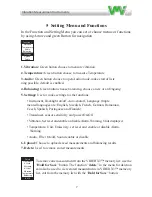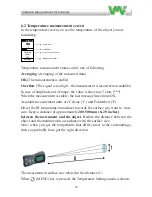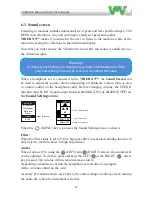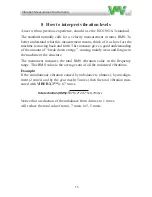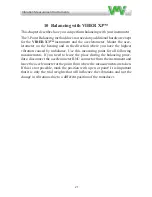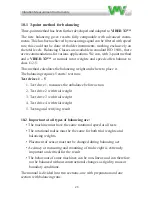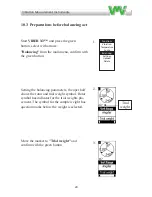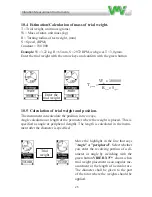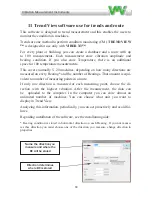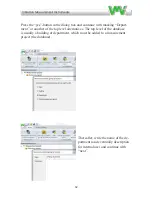
Vibraon Measurement Instruments
19
9.2 Recommended bearing condition levels
The bearing condition value is the total RMS value of the acceleration of all
high frequency vibrations within the range from 1500 Hz up to 20000 Hz
with the unit “g”.
Find the machine speed. Follow this line up to the judgment lines and read
the value on the left axis.
The diagram above is a guide to interpret the bearing condition value. If
vibrations of other causes (e.g. flow surge, gear mesh) are within in the
selected frequency range, this can give a high bearing condition value
without the bearing being damaged. A high bearing condition value can also
be acquired if the bearing is poorly lubricated or is overloaded (e.g. by misa-
lignment, or large belt forces).
Compare this value with the bearing temperature. If both are high or pointing
upwards in the trend analysis you might have a bearing problem.
2
11 – mm/s | 0,43
−
in/s
Very large vibrations and high noise levels. This is detrimental to the safe operation of the machine. Stop operation if
technically or economically possible considering the plant stop cost. No known machine will withstand this level without
internal or external damage. Reduce any further running time to an absolute minimum.
4.2
Resonance
A resonance can easily be found when a flexible machine is running up or down its speed. The resonance frequencies are
located at the rpm’s, where the vibration has a local maximum level.
To understand a resonance you can compare with the string of a guitar. The string has its natural basic tune that will ring
as soon as the string is struck. The actual frequency of the tune depends on the stiffness and the distributed mass of the
string.
All machines have similar built in "tunes" with corresponding properties consisting of stiffness and a mass in the form of
mechanical strings such as shafts, beams, floors and in all mechanical parts. If any natural excitation (=alternating force) in
the machine has the same or nearly the same frequency as a resonance frequency the vibration will be amplified in this
machine part, and a much higher vibration level will occur.
To identify, measure the vibration levels in three perpendicular directions at the bearings. If you find a measurement with
at least three times higher level than in the other directions you should consider resonance as a likely possibility. The
resonance is amplifying the mechanical force and thus gives a high vibration in that direction. The resonance makes the
machine unnecessarily sensitive to mechanical forces.
Actions to handle a resonance are different depending on its location, operating conditions etc. It will normally require
experience to alter the situation. One reason is that the modification can affect the basic mechanical design of the
machine and normally require the competence of a machine designer.
We recommend however to consider such modifications since the change of the resonance frequency normally is cheap
compared to the high maintenance cost that will follow any attempt to run a machine under the influence of a resonance.
4.3
Recommended bearing condition levels
The bearing condition value is the total RMS value of the acceleration of all high frequency vibrations within the range
from 1500 Hz up to 20000 Hz with the unit “
g
”.
Find the machine speed. Follow this line up to the judgment lines and read the value on the left axis.
Summary of Contents for VIBER X3
Page 2: ......
Page 38: ...Vibra on Measurement Instruments 36...
Page 39: ...Vibra on Measurement Instruments 37...
Page 41: ...Vibra on Measurement Instruments 39...
Page 43: ...Vibra on Measurement Instruments 41...
Page 46: ...Vibra on Measurement Instruments 44 Click on next...
Page 48: ...Vibra on Measurement Instruments 46 Click on next...
Page 58: ...Vibra on Measurement Instruments 56...
Page 59: ......



